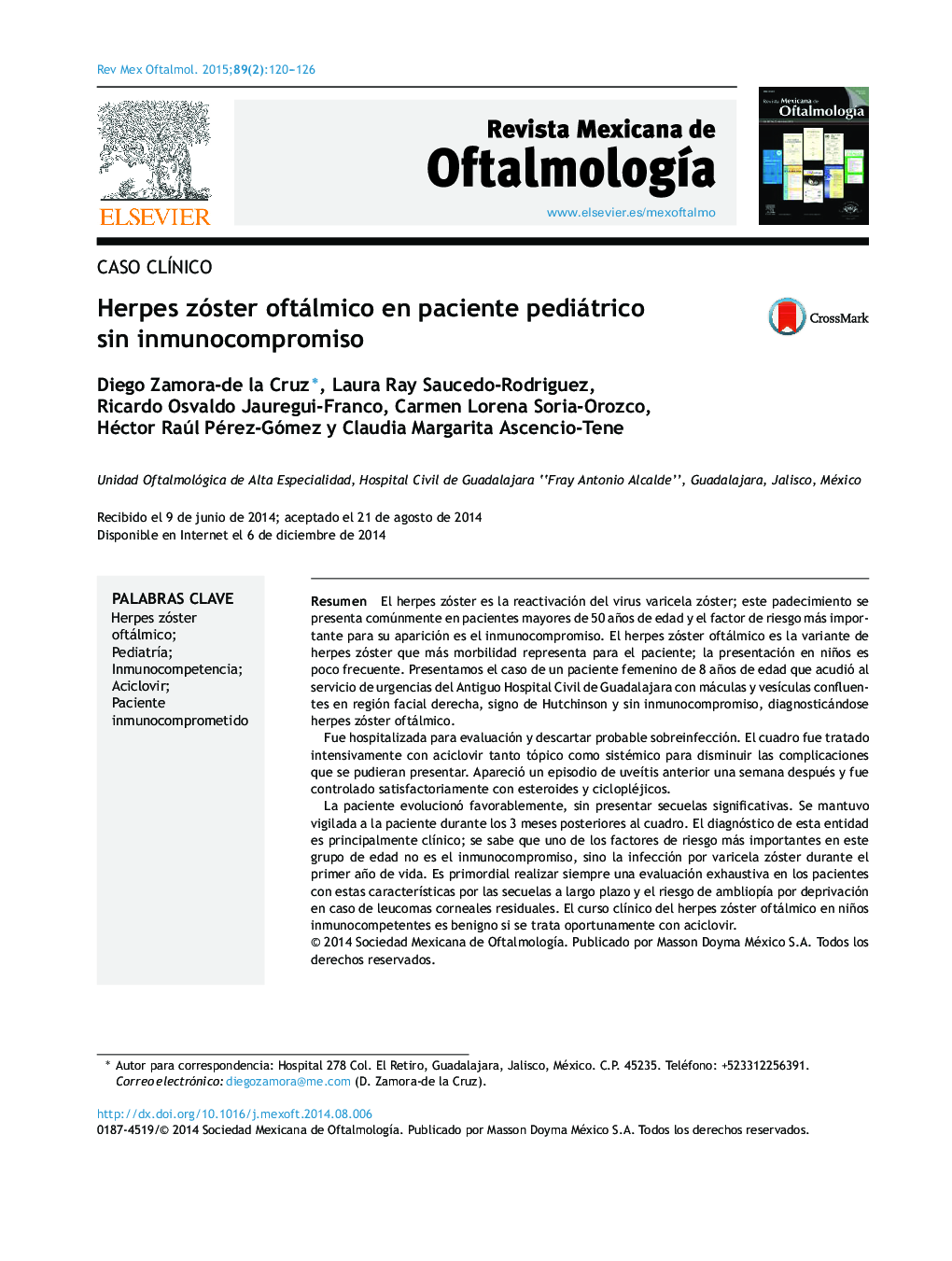| Article ID | Journal | Published Year | Pages | File Type |
|---|---|---|---|---|
| 4032280 | Revista Mexicana de Oftalmología | 2015 | 7 Pages |
ResumenEl herpes zóster es la reactivación del virus varicela zóster; este padecimiento se presenta comúnmente en pacientes mayores de 50 años de edad y el factor de riesgo más importante para su aparición es el inmunocompromiso. El herpes zóster oftálmico es la variante de herpes zóster que más morbilidad representa para el paciente; la presentación en niños es poco frecuente. Presentamos el caso de un paciente femenino de 8 años de edad que acudió al servicio de urgencias del Antiguo Hospital Civil de Guadalajara con máculas y vesículas confluentes en región facial derecha, signo de Hutchinson y sin inmunocompromiso, diagnosticándose herpes zóster oftálmico.Fue hospitalizada para evaluación y descartar probable sobreinfección. El cuadro fue tratado intensivamente con aciclovir tanto tópico como sistémico para disminuir las complicaciones que se pudieran presentar. Apareció un episodio de uveítis anterior una semana después y fue controlado satisfactoriamente con esteroides y ciclopléjicos.La paciente evolucionó favorablemente, sin presentar secuelas significativas. Se mantuvo vigilada a la paciente durante los 3 meses posteriores al cuadro. El diagnóstico de esta entidad es principalmente clínico; se sabe que uno de los factores de riesgo más importantes en este grupo de edad no es el inmunocompromiso, sino la infección por varicela zóster durante el primer año de vida. Es primordial realizar siempre una evaluación exhaustiva en los pacientes con estas características por las secuelas a largo plazo y el riesgo de ambliopía por deprivación en caso de leucomas corneales residuales. El curso clínico del herpes zóster oftálmico en niños inmunocompetentes es benigno si se trata oportunamente con aciclovir.
Herpes zoster is the reactivation of varicella zoster virus; this disease commonly occurs in patients over 50 years old and immunocompromise is known as the most important risk factor for the onset of this condition. Herpes zoster ophthalmicus is the clinical variant that gives more complications to the patient. Clinical presentation of this disease in children is rare. We aim to present an 8 year old female patient who, came to the emergency room of the Guadalajara's Civilian Hospital with macules and confluent vesicles on right facial region, Hutchinson's sign and no immunocompromise. Herpes zoster ophthalmicus was diagnosed. She was hospitalized for clinical evaluation and to rule out superinfection. This clinical scenario was aggressively treated with topical and systemic acyclovir in order to reduce possible complications. An episode of anterior uveitis appeared one week later and was successfully controlled with topical steroids and cycloplegic.Clinical course evolved without significant sequelae. The patient was kept under observation 3 months after the initial presentation. The diagnosis of this condition is primarily clinical. It is known that one of the most important risk factors in this age group is not immunocompromise but varicella zoster infection during the first year of life. It is paramount to perform an exhaustive evaluation in patients with these criteria to prevent possible long-term sequelae and reduce the risk of amblyopia in case of residual corneal leucomas. The clinical course of herpes zoster ophthalmicus in no-immunodeficient children is generally benign if treated promptly with acyclovir.
